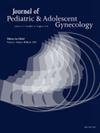21.病例报告:卵巢早衰是原发性闭经的原因之一
IF 1.8
4区 医学
Q3 OBSTETRICS & GYNECOLOGY
引用次数: 0
摘要
背景:卵巢功能不全(POI)是指40岁以下女性卵巢功能丧失,通过闭经或少经和两种促卵泡激素(FSH)水平升高来诊断。其患病率为1%至3.7%,在20岁以下妇女中每10,000例中有1例。70-90%的病例病因不明。已知的病因包括特纳综合征、脆性X染色体综合征、自身免疫、感染和医源性。未经治疗的POI可导致骨质疏松、心血管风险、阿尔茨海默病、精神健康障碍和不孕症。我们提出一例POI表现为原发性闭经,目的是强调早期识别和治疗的必要性。病例一名16岁女孩,无既往病史,以原发性闭经表现。她的体格检查显示身高172厘米,比她的目标身高高10厘米。她的乳房和阴毛呈坦纳二期,解剖上正常的女性外生殖器和低雌激素的粘膜。实验室检测显示卵泡刺激素水平为69 mIU/ml,未检测到抗本文章由计算机程序翻译,如有差异,请以英文原文为准。
21. Case report: Premature ovarian insufficiency as a cause of primary amenorrhea
Background
Premature ovarian insufficiency (POI) is the loss of ovarian function in women under 40 years, diagnosed through amenorrhea or oligomenorrhea and two elevated follicle-stimulating hormone (FSH) levels. Its prevalence ranges from 1% to 3.7%, with 1 in 10,000 cases in women under 20 years. In 70-90% of cases the etiology is unknown. Known causes include Turner syndrome, fragile X syndrome, autoimmunity, infections and iatrogenic. Untreated POI can lead to osteoporosis, cardiovascular risk, Alzheimer's disease, mental health disorders and infertility. We present a case of POI manifesting as primary amenorrhea, with the aim of emphasizing the need of early identification and treatment.
Case
A 16-year-old girl with no prior medical history presented with primary amenorrhea. Her physical exam showed a height of 172 cm, 10 cm above her target height. She had Tanner stage 2 in breasts and pubic hair, anatomically normal female external genitalia and hypoestrogenized mucous membranes. Lab tests showed FSH levels of 69 mIU/ml and undetectable anti-Müllerian hormone. The gynecological ultrasound indicated uterine length of 52 mm and ovarian volumes of less than 1cc. POI was suspected and confirmed with a second elevated FSH level. Investigations into possible etiologies were carried out, revealing a 46 XX karyotype, negative fragile X premutation studies, normal thyroid function and negative thyroid antibodies. A genetic evaluation was requested, which included testing for 53 genes in Disorders of Sexual Development Panels, all of which were negative. Additionally, to rule out the diagnosis of Triple X syndrome, which can cause tall stature and POI, an extended karyotype with 50 metaphases was requested, and the result is pending. Due to prolonged hypoestrogenism, a bone densitometry was performed, with normal results. The patient began low-dose transdermal estradiol, gradually increasing to 2 mg over two years, after which she had her first menstrual bleed. Monthly cyclic micronized progesterone was added. During treatment, she progressed to Tanner stage 5 for breast and pubic hair development, and her final height was 175 cm. Serial ultrasounds indicated progressive uterine growth, reaching 77 mm by age 20.
Comments
POI is a very rare diagnosis in women under 20 years, especially as a cause of primary amenorrhea. In our case, the patient presented arrested puberty at Tanner stage 2. While the cause is often unknown, ruling out common causes and monitoring for conditions like osteoporosis is crucial. Hormonal treatment should always be initiated promptly and continued until the average age of menopause to prevent hypoestrogenism-related complications.
求助全文
通过发布文献求助,成功后即可免费获取论文全文。
去求助
来源期刊
CiteScore
3.90
自引率
11.10%
发文量
251
审稿时长
57 days
期刊介绍:
Journal of Pediatric and Adolescent Gynecology includes all aspects of clinical and basic science research in pediatric and adolescent gynecology. The Journal draws on expertise from a variety of disciplines including pediatrics, obstetrics and gynecology, reproduction and gynecology, reproductive and pediatric endocrinology, genetics, and molecular biology.
The Journal of Pediatric and Adolescent Gynecology features original studies, review articles, book and literature reviews, letters to the editor, and communications in brief. It is an essential resource for the libraries of OB/GYN specialists, as well as pediatricians and primary care physicians.

 求助内容:
求助内容: 应助结果提醒方式:
应助结果提醒方式:


